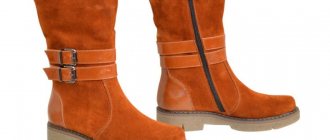A situation familiar to many: shoes that fit perfectly on the foot when purchased, on the very first day rub, pinch and cause discomfort. But don’t despair: today there are many effective ways to stretch leather shoes at home.
Genuine leather is a fairly soft and elastic material. It’s not difficult to stretch leather shoes using affordable home remedies.
We have prepared for you an overview of simple and accessible methods that everyone can master.
Army way
An effective and perhaps the easiest method to stretch leather shoes.
Take thick cotton or wool socks, soak them in hot water and wring them out to remove excess moisture. Put on a pair of shoes that need stretching and walk around the house until your socks are dry (or until you get tired of it). After this, dry the shoes using paper or newspapers. Ready. The skin will stretch under the influence of moisture, take the shape of the foot, and the shoes will no longer press.
In the army, according to rumors, this method is used somewhat differently - in socks and tight shoes they stand directly under a hot shower. But this is an extreme option for tough men
Suede or nubuck
When trying to stretch suede shoes, you need to remember that a wet fleecy surface instantly loses its decent appearance. Avoid options with exposure to moisture and sudden temperature changes.
When caring for suede and nubuck, you should not use oils or creams - they leave greasy stains that cannot be removed. Mechanical action works best.
Massage the boots thoroughly with your hands. Walk around in them for a few hours. Most often, this is enough to stretch suede or nubuck, because the natural material is quite elastic.
If that doesn't work, try making a steam bath:
- Pour silent water into a large saucepan and bring to a boil.
- Place a colander on top. It should not come into contact with liquid.
- Wrap the inside of suede shoes with a thin towel or cloth napkin.
- Place the pair in a colander, sole side up.
- Wait 2-3 minutes. Overheating is undesirable.
- Take out your shoes and put them on.
- You can stretch the narrow top of suede boots using a damp textile cloth and an iron. Place the fabric inside and iron at low temperature. After delicate processing, the boots will fit perfectly on your calf.
Freezing
To stretch leather shoes wider, you don’t have to wear them in for a long time and endure pain. You can use a more gentle method.
Take two strong plastic bags, place them inside the shoes and carefully pour water to fill the entire interior space from toe to heel. Tie the bags tightly to prevent water from escaping and place the shoes in the freezer. Leave to freeze for 6-8 hours.
As the water hardens, it expands and stretches the skin. After the time has passed, remove the shoes from the freezer, let the ice thaw a little and carefully remove the bags. Do not try to remove the ice immediately - you may scratch or tear your shoes.
The freezing procedure can be repeated if the skin is not stretched enough the first time
How to quickly break in new tight shoes
When a callus appears in the heel area, wearing a regular bactericidal patch on the area of redness for two or three days helps in most cases. During this time, the front part of the shoe wears out a little, and the load on the heel is noticeably reduced.
Prolonged wearing of the patch can also help when there is discomfort in one of the toes. The bactericidal patch has an additional thick layer that promotes greater stretching of shoes in a certain place.
In the case where the callus is already a fait accompli, the use of a patch is doubly justified.
If your shoes are too small: four universal tips
Way #1
First of all, you can turn to a shoe specialist for help. Workshops almost always have special stretching devices. If you think you need it, you can purchase a shoe stretcher and do it yourself at home.
Method No. 2
There is also a special product for stretching shoes on sale. It is suitable for all types of materials except patent leather. This is perhaps the most effective way.
You can find it in any department specializing in shoe care products.
As a rule, this is a special liquid composition. You can ask the seller or read on the packaging about how to use the solution, but most often it is enough to moisten a cotton swab and apply the product to the area that rubs your leg.
Wearing thin cotton socks, walk around in the treated shoes for about 40 minutes.
If your stretching agent comes in the form of a spray, you can use it to treat the inside of your shoes. Again, after treatment, you need to wear shoes for about 40 minutes, putting socks on your feet.
Suede products come in the form of foam; The principle of use is similar to the previous one. After treating the suede product from the inside, you stuff it tightly with newspapers or wear it around the house after putting on socks.
The basis of all products is alcohol and special chemical softeners, which have a pleasant smell due to the fragrances also included in the composition.
Method No. 3
How to wear small shoes using vodka, cologne or alcohol diluted with water?
To ensure that your new shoes or boots fit perfectly, moisten them inside with vodka and put them on your feet with thick socks. You will have to wear them around the house until they are completely dry.
Method No. 4
Freezing in the freezer is the most unusual way to stretch new shoes in length and width (a size larger). You will need a sealed plastic bag, your new shoes, a refrigerator and plain tap water.
Sequencing:
- put the bag in your shoes and fill it with water. It is important to ensure that the bag of water fills the entire surface - from heel to toe;
- place the bag of shoes in the freezer for at least eight hours;
- when water turns into ice, it needs more space, therefore the shoes will stretch;
- After time has passed, take out the ice pack and let it thaw a little. Do not try to immediately remove the ice from your shoes, otherwise you will tear or scratch them from the inside.
If after this procedure your leg still feels pinched or pressed, repeat the procedure again.
In our store you can buy men's shoes for any season: from summer clogs to winter boots.
And on this page girls and women can choose something for themselves. You can search by brand, color or material of shoes, size, price and other parameters.
There is a separate section for the youngest buyers
Hot way
There are two options for stretching shoes using a hot method: using a hairdryer and boiling water.
To stretch leather shoes with a hairdryer, put on thick socks, put your shoes on and squeeze your feet, as if stretching the shoes from the inside. Turn on the hairdryer and direct warm air streams to those areas where your shoes are pinching you. Do not bring the hair dryer too close to the skin and try not to direct hot air onto the taped seams. After completing the procedure, walk around in your shoes until they cool down.
After blow-drying, lubricate your shoes with a special cream to restore the balance of lost moisture. If there are no professional products, you can use regular hand cream or Vaseline
When stretching your shoes with a hairdryer, do not overdo it: you can dry out the leather and achieve the exact opposite effect.
An effective way to stretch leather shoes is to use boiling water. Before you begin stretching, be sure to remove the insoles from your shoes. Under the influence of boiling water, the insoles are greatly deformed, lose their appearance and begin to cause discomfort when walking.
Boil water, place the shoes over a container and carefully pour boiling water inside. Leave to act for just a few seconds and pour out the water. Blot the moisture, wait a couple of minutes for the shoes to cool slightly, and put them on, after putting on thick socks. Walk around in your shoes until they are completely cool. The hot water will soften the skin and as it cools it will mold to the shape of your foot. This method will help stretch leather shoes to fit.
If you are afraid of damaging the inner surface of the shoe, you can place a bag inside to create a cushion between the boiling water and the material
Do not use boiling water to stretch artificial leather shoes - only natural material will withstand exposure to temperature and moisture.
How to break in tight leatherette shoes
The task of stretching narrow faux leather shoes can be almost impossible, but we know effective ways.
Try these recipes:
- Soak thick socks in any cologne and, putting them on your feet, walk in tight shoes for about 20 minutes. The procedure is repeated daily at least 10 times until a suitable result is obtained. The pungent smell of cologne can be eliminated with a soap solution and airing.
- The wet newspaper is shredded very finely, filled with water until it swells, and the entire volume of tight shoes is filled with this mass. Dry the shoes for two days under natural drying conditions, away from any heating devices.
Alcohol
Soak the inner surface of the shoes with an alcohol solution (water and alcohol 1:1) or vodka. For convenience, you can use a spray bottle. Wear thick socks and walk around in your shoes for about an hour. The pungent odor after the procedure can be eliminated with a soap solution (or simply leave the shoes in the air). Alcohol dries out the skin; After stretching, lubricate your shoes with special cream or Vaseline.
The alcohol solution can be replaced with an alcohol-based window cleaner or cologne.
Use alcohol-containing liquids carefully on colored shoes. Pre-test the paint for durability by treating an inconspicuous area of skin with alcohol.
Use of special means
A semi-professional method of stretching shoes is the use of specialized products: aerosols, sprays or foam. They are easy to use by studying the instructions, which differ little from different manufacturers and include the following points:
- Shake the can thoroughly.
- Apply the liquid liberally to the inside or outside of the shoes.
- Let it soak in for a few seconds, put the boots on with thick socks, and leave them on for 30-40 minutes.
- Remove excess moisture (if any) by wiping the surface with a soft cloth.
Stretching agents can be used together with wooden lasts; in this case, the shoes should be left in this form overnight. If necessary, pads can be added to the mechanical stretches to suit the specific needs of the foot. This will allow you to effectively stretch the pair without breaking them in.
Apply the aerosol to the entire surface of the shoes
Wear a pair with a warm sock and walk for 40 minutes
Remove excess moisture
Oils
Leather shoes made from both natural and artificial materials can be stretched using oils. Castor or other vegetable oil, as well as Vaseline (can be replaced with fatty cream), are suitable for this purpose.
Remove the insoles from the shoes, lubricate the areas where the shoes are pinching with oil or Vaseline (you can treat both the inner and outer surfaces), and leave for several hours. After this, thoroughly wipe your shoes, put on thick socks, put on your shoes and walk around the house. The oil softens the skin, it becomes more pliable and stretches to fit the shape of your leg.
The oil will help stretch not only new shoes, but also tidy up a rough pair of shoes that you haven’t worn for a long time.
Lubricate the areas where the shoes feel tight with oil. Let the boots sit for several hours. Then thoroughly wipe your shoes, put on thick socks, put on your shoes and walk around the house
Are any shoes stretchable?
Genuine leather just stretches. Suede is especially flexible. But artificial ones can cause difficulties and become damaged if due care is not taken. The following list includes materials that stretch without harm:
- Leather
- Suede
- Textile
- Nubuck
If the shoes are expensive, it is better to contact a workshop specialist. They will complete the task efficiently, as they use the appropriate equipment. Shoes and boots are increased by one size without haste or damage.
Traditional methods
Vinegar is often used to soften and stretch leather shoes . The smell, of course, is unpleasant, but it disappears quite quickly in the fresh air.
Moisten the inside of your shoes with table vinegar (3-9%) in the places where they feel tight, put on thick socks and walk around the house for about an hour. The pungent odor from vinegar can be eliminated with a soap solution (or by airing out your shoes).
Use vinegar with caution on colored shoes. Pre-test the paint for durability on an inconspicuous area of the skin.
To stretch thin leather or delicate suede, you can use beer . The technology is the same: saturate the shoes from the inside, put on thick socks, put on your shoes and walk around for a couple of hours. To get rid of beer smell, air your shoes in the fresh air.
One of the most common ways to stretch leather shoes is to fill them with wet newspapers .
Newspapers or sheets of paper are cut into very small pieces, tightly stuffed into leather shoes and filled with water. The paper swells from moisture and tightly fills the internal space. The shoes and paper are dried naturally away from heating devices (about 2 days). This method is time-tested, but it is not recommended for light shoes - it is more suitable for shoes or boots.
How to break in new suede shoes
If your nubuck or suede shoes turn out to be tight, it’s time to look into the freezer compartment of the refrigerator in search of free space. This method is already described in detail in the subtitle with four universal tips.
But there is another method specifically for suede, because this material requires a delicate approach.
Ordinary beer has these qualities. The technology is very simple: you should thoroughly wet the inside of the shoes with beer, put them on thick socks, wear them for a couple of hours, and then thoroughly ventilate them in the open air.
Experience shows that the size often becomes larger than you planned , so be careful.
Cowboy way
In the Wild West, grain was used to stretch leather boots. They filled shoes with it, filled it with water and left it overnight. The grain absorbed water, swelled and stretched the skin. In the morning, the shoes were freed from the filling, wiped and worn until dry.
This method has the right to exist today. However, it cannot be used for lined shoes
What to do if your shoes are too tight?
New shoes often chafe and can pinch your feet in a variety of places. And it’s not surprising, because everyone has different instep, width and other parameters of the foot, and shoes are made in production according to standard measurements.
There are three ways to deal with the problem:
Contact a specialist and have your shoes stretched. But you also need to take into account the professionalism of the chosen master. It turns out that not everyone can handle patent or suede leather, and besides, special equipment is needed to stretch such a delicate material. Before handing over your new item, ask the technician where and how he plans to solve your problem.
Go to the store for a special product that helps soften shoes in areas of rubbing and stretch them a little. The inconvenience of this method is that you need to find a suitable composition for the material of your shoes, and no one can guarantee that it will work exactly as you need. It may be a waste of money and time.
Turn to people for advice. For a long time, people have figured out how, with the help of objects and things that are in every home, they can stretch their shoes and not suffer from wounds and dropsy.
Modern chemistry
Today, on store shelves there is a decent selection of special means for stretching shoes: foams, sprays and aerosols. From a rich assortment you can choose the option that suits your pocket. How to use the chosen product, read the manufacturer's instructions.
For expensive shoes made of thin leather, it is better to use modern foams or stretching sprays - all other methods can damage the delicate material and ruin your shoes
Choosing the right dress shoes
When choosing a new pair, use a few simple tips:
- Make purchases in the late afternoon when your foot size is at its maximum;
- The feeling of the toes when trying on should come first, as you need to feel a certain freedom;
- It is necessary to monitor the fullness indicated by the manufacturer, since each of them is guided by its own size;
- When buying products for every day, choose a low heel from three to five centimeters.
Trying on both boots and shoes, as well as sandals, is necessary on two feet at the same time to determine that they are the same size.
It's worth walking on the floor a little to evaluate how comfortable the pad is for you. It is recommended to wear models of various types, only in this case the foot will not get used to only one type of last.
You should be especially careful when choosing shoe models for children. A child’s foot and boot are just beginning to form, so the wrong choice of shoes, even for one season, can lead to musculoskeletal problems later in life.
Mechanical stretch
Today it is not difficult to buy a special mechanical stretcher in a shoe store. It is a wooden (or plastic) block, which is equipped with a screw mechanism for forceful expansion. The kit, as a rule, contains a spray and special pads of various shapes that will help stretch the shoes in certain areas (if there is a bone, crooked fingers, calluses and other orthopedic indications).
A mechanical shoe stretcher can be purchased for home use. Its cost is relatively low, and its effectiveness is obvious
How many sizes can shoes be stretched to?
Leather and suede are materials that have stretch. Sellers manipulate this when they sell goods. They assure that the model must be taken end-to-end, as it will stretch and will spank in a month. I often succumbed to their tricks and bought tight shoes. Maybe I came across a low-quality product or a product made of leatherette, because leather and suede really stretch, fit well on the foot and quickly take its shape, even without stretching.
Before moving on to a review of proven methods, let's find out how many centimeters it is possible to stretch shoes? After all, 1 cm is equal to approximately 1 size, that is, you actually need to change the pad if you feel too tight.
Master's opinion
If you bought shoes in a smaller size, it is better not to try to pull them. For the skin, stretching by 1 cm is no longer good. At first it stretches, but then it can easily crack. Make sure you don’t remind yourself of the wolf from the cartoon “Well, wait a minute!”, who pulled the skates onto his paws, increasing them by 3 sizes.
In workshops, they most often undertake to stretch shoes in width or stretch the tops, but not always in length, and if they do, it is by millimeters, not centimeters. That's why. By stretching the top of the shoe by 1 cm or more, you pull it over the sole. Simply put, your sole is size 37, and you want to stretch the upper to 38. It will seem to hang over the sole, and the lifespan of shoes stretched in this way will decrease. Masters recommend stretching a maximum of 2-3 mm in length. For this they use special blocks with an exact length, and do not pull at random in different directions. It's a little easier to stretch it wide, since you won't break the block. In this case, aim for about half a size.
Let's move on to a review of the most popular methods that you can try at home.
Professional approach
If finances allow, then you can use the services of professionals - this is the fastest and most effective way to get rid of problems with new shoes.
By the way, there is an opinion that it is impossible to stretch leather shoes in length. In general, this fact cannot be refuted, but today professionals can offer a solution to this problem. As a rule, the leather at the toe of the shoe is thicker, and thanks to the combined effects of mechanical stretching, spray, special attachments and electrical heating, this area of leather can be stretched to give more room to the toes.
Check the availability of shoe stretching services in workshops in your city
Getting rid of chafing
Any shoes can rub the skin, even those that have already been worn in, but have not been used for a long time. But friction occurs especially often in open summer shoes.
To prevent unpleasant calluses from forming on the skin, which can quickly turn into bloody wounds, it is better to use modern anti-chafing agents from the first days of wearing the products:
- Sticks for calluses . They are made on a solid fat base and are designed to treat the skin in problem areas and areas that are likely to chafe. The products reduce skin friction on the material and leave no marks.
- Special stripes . They are made on an adhesive basis - the device is glued to those places that can be pressed and rubbed. They effectively protect the skin and cope with the problem of chafing.
- Gel pads or heel pads . The transparent, ultra-thin devices are glued to the inside of the shoe, making them invisible. The product secures the foot in the shoe, prevents slipping and makes the gait more confident. Heel guards are especially relevant for lovers of high-heeled shoes and sandals.
- Callus patch . It is used when trouble has already occurred and a callus has formed on the skin. It is best to use an antibacterial patch based on salicylic acid. It has softening and antibacterial properties and prevents the appearance of suppuration.
What to do to prevent new shoes from rubbing calluses is described in the video:
If all of the above methods of stretching shoes did not help, most likely the model will no longer be able to be increased in length and width.
Therefore, it is recommended that even at the time of purchase, you carefully study the item you like and do not buy shoes that are too tight in the hope that over time they will “break apart” on your feet.
Useful tips
In conclusion, some more useful tips:
- buy shoes in the afternoon, when your feet are slightly swollen, to avoid problems with the size later;
- do not put on new shoes for the whole day at once, break them in gradually;
- Cover frequently rubbed areas with adhesive tape in advance. This will avoid the appearance of calluses;
- if the back of the shoes rubs, lubricate it with paraffin or soap;
- Buy shoes for important events in advance, keep in mind that you will need time to stretch. Read about how to quickly break in new shoes in our other article.
If you have already tried the methods listed above or have your own method of stretching shoes, share your experience and tips with us in the comments.
How to stretch individual parts?
When breaking in new shoes, discomfort often occurs in a certain area, for example, the shoe pinches in the toe or rubs in the heel.
It is not difficult to solve this issue. You need to apply already known methods locally:
- Hairdryer or steam generator. Direct a stream of hot air at the problem area. Sometimes warming up is enough.
- You can put a large potato in the toe of your shoe. The peeled root vegetable will help stretch the straps of uncomfortable sandals.
- Cream. If your shoes rub on the back, you should generously lubricate the heel with oil or rich cream. Feel free to put on your shoes - you won't be afraid of blisters.
- Hot water. In the case of genuine leather, you can pour boiling water over a narrow toe or hard heel.
- It is better to dry the products on your feet.
- When shoes rub the heel, you can treat the back of the shoe with a 3% vinegar solution. The unpleasant smell of the essence will quickly disappear, and the material will become soft.
- If the backdrop is too hard, gently tap it with a hammer from the inside.
Professional ways to increase size
If for some specific reason you are unable to return your tight sneakers back to the store, then use professional stretching products. In workshops for repairing sneakers, it is common to use:
- surface treatment fluids;
- pads on which the shoes themselves are pulled, requiring stretching.
Manufacturers advise using sprays and stretching foams
When purchasing them, you need to pay special attention to the features of use. If the spray is marked “for all types of natural leather,” then it will not be suitable for textile sneakers at all.
Method of use:
- Shake the balloon filled with stretch foam.
- Apply the contents of the product evenly and efficiently to problem areas from the inside as well as the outside.
- Wear wet shoes with terry or wool socks.
- Walk in it until the applied product dries completely.
- Repeat the procedure several more times to completely get rid of discomfort.
Before using foam or spray, you need to test the effect of such a product on an inconspicuous area of the sneaker.
An analogue of a professional last will be a mechanical device: shoe spacers, special mechanical stretchers, mold holders. Usually they are completely universal and are suitable for several sizes and different thicknesses at once. The spacers include a special screw mechanism that provides good tension. Also included are plastic pads for the protrusions in the foot. Such devices cost a lot, but they can be used more than once.
Methods of using mechanical spacer for shoe products:
- Sneakers should be treated with a special stretching spray or moistened with water.
- You need to install a mechanical spacer inside the sneakers or sneakers, having previously installed plastic linings on it.
- Using a screw mechanism, you need to give the shoe the desired tension. This should be done carefully so as not to accidentally damage the material.
- Leave until completely dry.
- If necessary, the procedure must be repeated.
If you cannot get rid of the problem yourself, then you need to entrust your shoes to a specialist. A specialist will be able to accurately fit the shoes to the desired size and characteristics of the foot, while fully maintaining the quality of the product and its appearance.
Sprays and impregnations for stretching shoes
On store shelves there is a wide range of not only aerosols, but also creams that can be used to stretch shoes made of any material.
When selling branded shoes, sellers usually offer to buy stretching agents of the same brand for a new pair of shoes or boots, manipulating that the manufacturer has invented a unique composition that is ideal for this type of material. Based on customer reviews, it became clear that there is nothing special about such sprays; they are no better or worse than other brands, which are also suitable for shoes of any brand.
Top most popular aerosols and impregnations
- Salamander is a universal foam suitable for all types of leather, except for varnish coating, as it is not absorbed.
- Kiwi - suitable for both leather and suede.
- Stretcher - German impregnation suitable for natural and artificial leather.
- Tarado - softens and promotes stretching of leather and suede.
- Twist - suitable for leather, suede and even velor.











